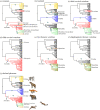Uncovering the mosaic evolution of the carnivoran skeletal system
- PMID: 38263882
- PMCID: PMC10806395
- DOI: 10.1098/rsbl.2023.0526
Uncovering the mosaic evolution of the carnivoran skeletal system
Abstract
The diversity of vertebrate skeletons is often attributed to adaptations to distinct ecological factors such as diet, locomotion, and sensory environment. Although the adaptive evolution of skull, appendicular skeleton, and vertebral column is well studied in vertebrates, comprehensive investigations of all skeletal components simultaneously are rarely performed. Consequently, we know little of how modes of evolution differ among skeletal components. Here, we tested if ecological and phylogenetic effects led to distinct modes of evolution among the cranial, appendicular and vertebral regions in extant carnivoran skeletons. Using multivariate evolutionary models, we found mosaic evolution in which only the mandible, hindlimb and posterior (i.e. last thoracic and lumbar) vertebrae showed evidence of adaptation towards ecological regimes whereas the remaining skeletal components reflect clade-specific evolutionary shifts. We hypothesize that the decoupled evolution of individual skeletal components may have led to the origination of distinct adaptive zones and morphologies among extant carnivoran families that reflect phylogenetic hierarchies. Overall, our work highlights the importance of examining multiple skeletal components simultaneously in ecomorphological analyses. Ongoing work integrating the fossil and palaeoenvironmental record will further clarify deep-time drivers that govern the carnivoran diversity we see today and reveal the complexity of evolutionary processes in multicomponent systems.
Keywords: Carnivora; Ornstein–Uhlenbeck modelling; adaptive landscape; ecomorphology; macroevolution; phylogenetic comparative methods.
Conflict of interest statement
We declare we have no competing interests.
Figures


Similar articles
-
Decoupled evolution of the cranium and mandible in carnivoran mammals.Evolution. 2022 Dec;76(12):2959-2974. doi: 10.1111/evo.14578. Epub 2022 Aug 9. Evolution. 2022. PMID: 35875871
-
Evolutionary ecomorphology for the twenty-first century: examples from mammalian carnivores.Proc Biol Sci. 2023 Nov 29;290(2011):20231400. doi: 10.1098/rspb.2023.1400. Epub 2023 Nov 29. Proc Biol Sci. 2023. PMID: 38018109 Free PMC article. Review.
-
Impact of the terrestrial-aquatic transition on disparity and rates of evolution in the carnivoran skull.BMC Evol Biol. 2015 Feb 4;15(1):8. doi: 10.1186/s12862-015-0285-5. BMC Evol Biol. 2015. PMID: 25648618 Free PMC article.
-
Ecological Drivers of Carnivoran Body Shape Evolution.Am Nat. 2021 Sep;198(3):406-420. doi: 10.1086/715588. Epub 2021 Jun 29. Am Nat. 2021. PMID: 34403311
-
Contextualising primate origins--an ecomorphological framework.J Anat. 2016 Apr;228(4):608-29. doi: 10.1111/joa.12441. Epub 2016 Feb 2. J Anat. 2016. PMID: 26830706 Free PMC article. Review.
Cited by
-
Skull evolution and lineage diversification in endemic Malagasy carnivorans.R Soc Open Sci. 2024 Oct 23;11(10):240538. doi: 10.1098/rsos.240538. eCollection 2024 Oct. R Soc Open Sci. 2024. PMID: 39445090 Free PMC article.
-
Gliding toward an understanding of the origin of flight in bats.PeerJ. 2024 Jul 25;12:e17824. doi: 10.7717/peerj.17824. eCollection 2024. PeerJ. 2024. PMID: 39071138 Free PMC article.
-
Evolution of the batoidea pectoral fin skeleton: convergence, modularity, and integration driving disparity trends.Evol Ecol. 2025;39(1):111-134. doi: 10.1007/s10682-025-10330-x. Epub 2025 Feb 17. Evol Ecol. 2025. PMID: 40026440 Free PMC article.
-
The Carnivoran Adaptive Landscape Reveals Trade-offs among Functional Traits in the Skull, Appendicular, and Axial Skeleton.Integr Org Biol. 2025 Jan 11;7(1):obaf001. doi: 10.1093/iob/obaf001. eCollection 2025. Integr Org Biol. 2025. PMID: 39850959 Free PMC article.
-
Mosaic evolution underlies feliform morphological disparity.Proc Biol Sci. 2024 Aug;291(2028):20240756. doi: 10.1098/rspb.2024.0756. Epub 2024 Aug 14. Proc Biol Sci. 2024. PMID: 39137889 Free PMC article.

